After a full 3x feeding of Francesca Fiore (my hydrated sourdough starter) for a day of baking last weekend, I found myself with an extra blob of her that I didn't want to just throw out. Flipping through Nancy Silverton's Breads from the La Brea Bakery , I saw the English Muffins recipe and was reminded of Sunday mornings when I was kid, waking up early with my Dad and munching on Thomas' English Muffins slathered with butter and strawberry jam. I decided to give them a shot.
, I saw the English Muffins recipe and was reminded of Sunday mornings when I was kid, waking up early with my Dad and munching on Thomas' English Muffins slathered with butter and strawberry jam. I decided to give them a shot.
I'll start with her recipe:
SPONGE:
18 oz White Starter
2 cups milk
8 oz unbleached white bread flour
3.5 oz dark rye flour
DOUGH:
Sponge
10 oz warm water (85 degrees)
0.9 oz fresh yeast
1/4 cup wheat bran
1/4 cup wheat germ
1/4 cup flax seeds
1/4 cup rye chops
1/4 cup raw sunflower seeds
8 oz unbleached white bread flour
1/4 cup barley malt syrup
1/4 cup vegetable oil
1 tbs sea salt
Rice flour for dusting
2 tbs unsalted butter, melted
Semolina flour for dusting
Here are the ingredients that I used based on what I had on hand.
SPONGE:
18 oz White Starter
2 cups plain soy milk
8 oz unbleached white bread flour (high extraction - 14% protein)
3.5 oz dark rye flour
DOUGH:
Sponge
10 oz warm water (85 degrees)
0.3 oz of SAF instant yeast
1/4 cup oat bran
3 tbs wheat gluten
1/4 cup flax seeds
1/4 cup coarse rye flour
1/4 cup raw sunflower seeds
8 oz unbleached white bread flour (high extraction - 14% protein)
1/4 cup (minus a smidge) agave nectar
1/4 cup vegetable oil
1 3/4 tbs kosher salt
Cake flour for dusting
Semolina flour for dusting
I made the sponge on a Sunday, but did not have the time to actually make them that night so I put it immediately into the fridge to ferment overnight. The next day, I removed it and it was nice and bubbly with a good odor.
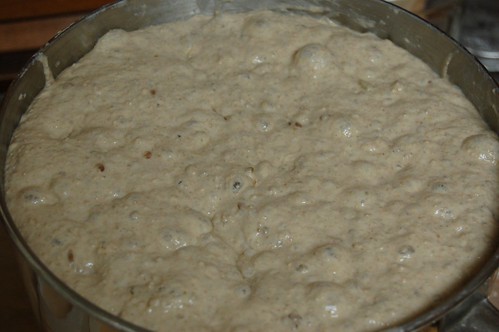
I assembled the dough, let it ferment at room temperature for about an hour before I realized I wouldn't have time to bake that evening either. Into the fridge it went and the next day I set out to bake it. I let it come back to room temperature and then put in on a cutting board dusted with cake flour to rest, dusting the top with semolina flour for good measure.
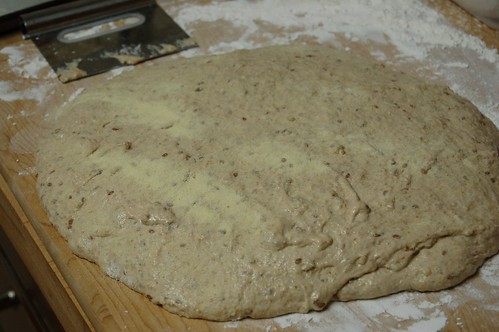
At this point, the recipe calls for 15 muffin rings to be buttered and placed on a parchment-lined baking sheet, muffin rings are not in my baking arsenal (butter is). Instead of emptying out cans of tuna on both ends and washing them (as Silverton suggests), I opt for the less fishy route and construct my own rings out of parchment paper.
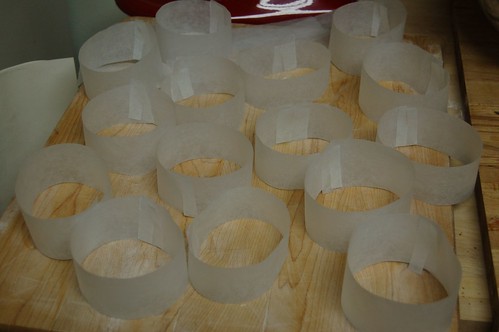
I thought this was pretty smart, since I didn't have to waste the butter to coat them. Once the muffins were done, I could just peel off the paper and enjoy the deliciousness of fresh English muffins. I placed the rings on baking sheets dusted generously with semolina flour and then filled with the dough. Here's where my paper rings idea started to collapse--literally.
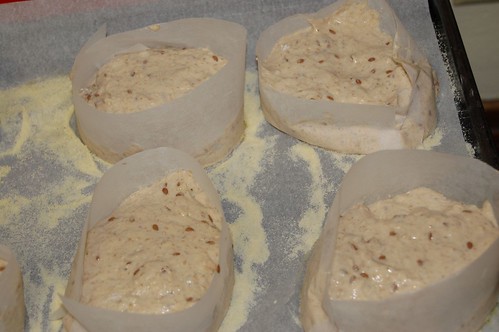
Although they were having trouble containing the dough, they did a good job of maintaining the basic muffin shape and I was happy with that.
I wish I had captured the moment when one of my cats jumped on the pan of resting muffins landing a foot in at least two of them and then proceeding to track dough across the entire kitchen. Luckily, I caught him before he hit the rugs.
After an hour of rest, I dusted the muffins with semolina flour and put them into a preheated 400 degree oven and baked for 20 minutes. I then removed the pans, rotating them and flipping the muffins over. I was a bit discouraged at the look of the muffins after the first 20 minutes; they were turning out like giant biscuits. But sally forth, home baker!
After another 20 minutes of baking, I pulled them out of the oven set them out to cool. They were definitely looking more like English muffins and less like biscuits. About an hour later, I removed the parchment paper rings and laid them out for a photo shoot.

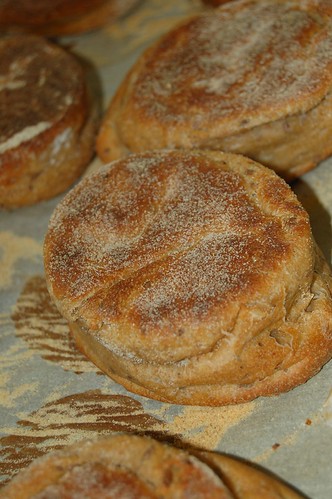
Time to pull apart and taste!
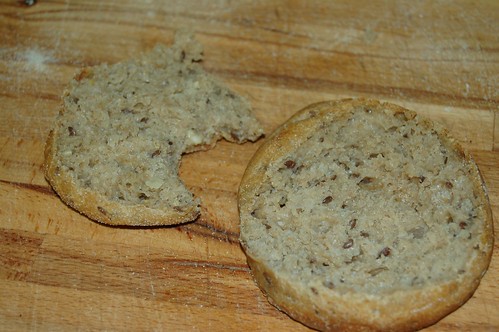
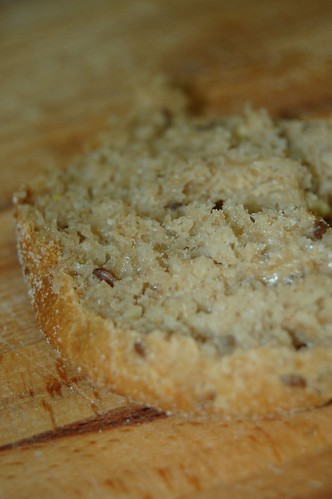
I'm a bit ashamed here. I couldn't even wait to take the picture before biting into one. They were/are pretty tasty little devils, but almost nothing like a Thomas' muffin. To my palate, much better tasting. The texture of the crumb was a little gummy, however, and I'm guessing it was because I used a bit too much rye flour in the dough and perhaps because of the extra time I gave the dough to ferment. If I had known I wasn't going to bake them the day I made the dough, I would have left out most if not all of the instant yeast. My substitution of the wheat gluten for the wheat bran was a mistake as well. In hindsight, I should have used some oats or millet. The agave nectar imparts an interesting sweetness to the muffins, but I could have cut it down to 2.5 tbs for a better flavor. The texture with the seeds is great. I'm definitely going to try these again with some small changes.